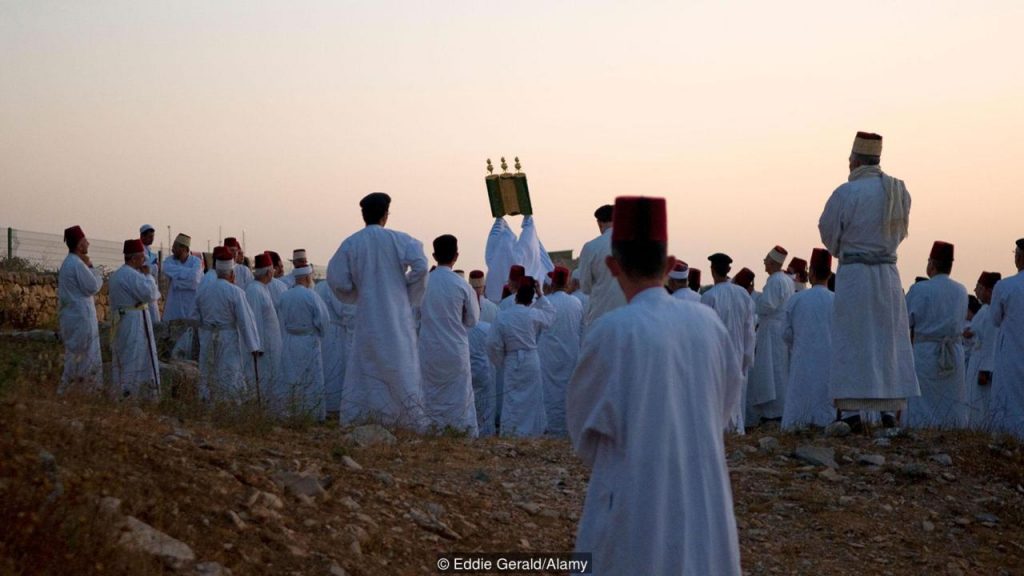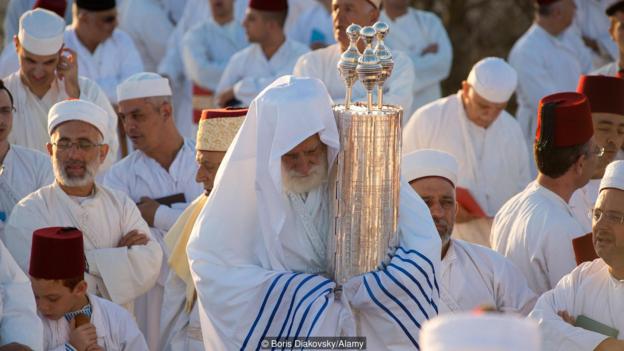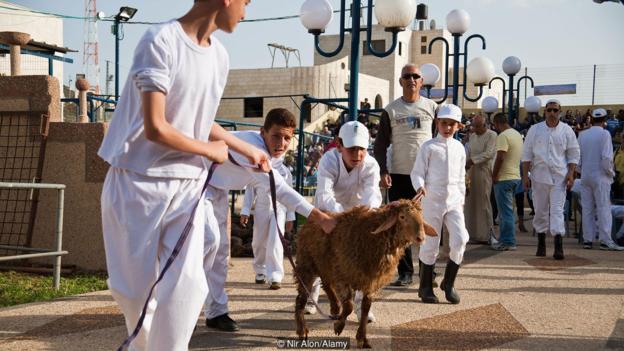You may well be aware of the New Testament parable of the good Samaritan. But you probably don’t know that there are around 800 ancient Israelite Samaritans still living today.
When people call someone a ‘good Samaritan’, they may know the parable of the good Samaritan from the Gospel of Luke, where a Samaritan helped a man who was beaten, stripped of his clothes and left by the roadside to die. But they probably don’t know that there are hundreds of ancient Israelite Samaritans still living today. I was so fascinated when I heard this that I decided to find a way to meet them when I was in Israel.
My first visit was at the turn of the new millennium. Although tension was high between Israelis and Palestinians, I found a tour guide who agreed to drive me from Israel to the northern West Bank and then up Mount Gerizim to the Samaritan village of Kiryat Luza. We passed modest limestone houses and arrived at the dusty main street, where the guide stopped in front of a small, two-storey museum. Inside, it was the size of a large living room, and I saw a diorama of ancient priestly garments, a sample of round matza (unleavened bread) and a genealogical tree in the shape of a menorah (seven-branched candelabrum) that went back thousands of years.
One wall was covered with photographs of austere, bearded old men wearing turbans. The priest, who was the guardian of the museum, pointed to one of them and said, “That was my father, the kohen gadol, or high priest of the Samaritans. The priestly lineage goes back to Aaron, the brother of Moses.”
“Moses of the Ten Commandments?” I asked. He nodded.
And that’s when I lost it. I began to cry, and the tears never stopped until I left the mountaintop. I felt I had encountered something that was very ancient, powerful and true.
Many visitors to the sacred Mount Gerizim are Christians, drawn by the New Testament parable and the fact that the Samaritans still speak the ancient Hebraic language that Jesus spoke. According to Biblical tradition, the Israelites were divided into 12 tribes and the Israelite Samaritans say they are descended from three of them: Menasseh, Ephraim and Levi. After the Exodus from Egypt and 40 years of wandering, Joshua led the people of Israel to Mount Gerizim. There he united the tribes with a ceremony that included a blessing for Mount Gerizim (which became known as the Mountain of the Blessing) and a curse for Mount Ebal (the Mountain of the Curse).
I felt like I’d been catapulted back to the days of the Hebrew Bible. When I returned home to the US, I emailed Benyamim (Benny) Tsedaka, a scholar, historian and ambassador-at-large for the Israelite Samaritans. He explained that “There were two ancient kingdoms: Judea (Jews) from the south, and we were the tribes from the north. We eventually separated, but our origins are identical.” He said that in the 6th Century CE, the Israelite Samaritans numbered 1,500,000. They were persecuted and killed for practicing their ancient faith by Greeks, Romans, Byzantines, Arabs, Crusaders, Mamluks and Ottomans. By 1919, there were only 141 Samaritans left. Today they number more than 800, with half living in Holon (south of Tel Aviv) and the other half on the mountain. They’re one of the world’s oldest and smallest religious groups and their songs are among the most ancient in the world.

Several years later, on my second visit to the region, I went to Holon to meet Tsedaka. Tall, grey-haired, with cocoa-coloured skin and a penchant for telling jokes, singing Shirley Bassey songs and Broadway tunes, he talked passionately about his people, called me ‘achot’ (sister) and insisted I call him ‘ach’ (brother). We walked around Holon, where about 80 Samaritan families were then living and working as lawyers, teachers, bankers and engineers.
“No-one is a doctor,” Tsedaka explained, “because that would mean working on Sabbath, which is strictly forbidden.”
We approached the Samaritan synagogue, a small building with a red-tile roof, limestone walls and a seven-branched candelabrum above the entry gate, inscribed with ancient Hebrew writing. Inside were piles of prayer books but no seats. Tsedaka explained that the men kneel or sit on the floor, and their Torah (holy book) has three crowns on it, which represent their three tribes of origin. Men are obliged to attend synagogue on Sabbath; for women, it’s optional.

On Friday afternoon, before the Sabbath, Tsedaka drove me from his house in Holon through the West Bank, arriving at his second home in Kiryat Luza without incident, even though a Palastinian uprising was roiling in the area. The Samaritans who live on their sacred mountain, between Palestinians in the West Bank and Jews in Israel, try to be a neutral bridge of peace between the two. Many Samaritans speak Arabic, have Arabic names in addition to Hebrew names, and speak both ancient and modern Hebrew; some speak English as well.
Tsedaka took me to the Samaritans’ three holiest places on the mountain: where Abraham brought Isaac to be sacrificed; the 12 stones where Joshua united the tribes after the Exodus; and a large, empty slab of deep-grey stone where the Israelites erected the Tabernacle when they arrived in Israel. “This is called the Eternal Hill,” Tsedaka said. “It’s the holy of holies. I know the Jews have another version of where these events took place, but our history says they happened here.”
We walked around the Mount Gerizim archaeological site which had recently opened. More than 500 ancient stone inscriptions were found here, Tsedaka told me, in addition to Persian, Hellenistic, Byzantine and Samaritan ruins and artefacts. Today the area is a national park, maintained by Israel.
As the sun lowered on the horizon, we entered Tsedaka’s house to prepare for Sabbath. Tsedaka went into his bedroom, and when he emerged, I was shocked by his transformation. He wore traditional ancient Israelite clothes: a long, white robe, tarboosh (red cylindrical hat with the white band of an elder) and sandals. We walked down the main street to the synagogue, joining other men and boys dressed like Tsedaka heading in the same direction. They left their sandals outside the sanctuary door. Inside, they sat, kneeled and stood on rugs, sometimes bowing their heads in the direction of their ancient Tabernacle. The sound of their prayers was deep and throaty. When they said the name ‘Moses’, they covered their faces with their hands as Moses did when God spoke to him.
After the service, a group of men approached me at the back of the synagogue, where I was sitting on a plastic chair. They asked me a pressing question: “Do you know if Maccabee Tel Aviv won?” It was their favourite basketball team. Samaritans are not permitted to watch television or use anything electric on the Sabbath. But even on their holiest day of the week, they still wanted to know how their team had done.
Tsedaka, like all the other men, goes to the synagogue three times on the Sabbath day, starting at 03:30. At 11:00, Tsedaka’s wife Miriam served lunch: copious amounts of salad, hummus, tahini, round matza, fried green beans, potatoes and fillet of sole. At 13:00, we headed back to the synagogue for 90 minutes of melodic prayer, and then visited several Samaritan homes, which is a custom on Sabbath. One of the community’s political leaders had a sumptuously decorated room dotted with photos of him with former Palestinian leader Yasser Arafat and King Hussein of Jordan.
“We get along with Palestinians and Jews,” Tsedaka said, “and we want to propose Mount Gerizim as an international peace centre.”
As the sun set, half of the men did their final prayers for Sabbath in the synagogue and the other half on the sacrificial grounds on Mount Gerizim where the startlingly gory Samaritan Passover takes place. Every year, scholars and tourists come from around the world to witness the Paschal sacrifice, which is performed as it’s described in the Book of Exodus. The High Priest examines each family’s lamb or sheep to make sure it has no blemishes. All the animals are slaughtered at once, and roasted on spits in large, sunken fire pits. It’s a bloody ritual, and participants, dressed in white, spread blood on their foreheads to stave off the angel of death. At midnight, the roasted lamb is consumed rapidly with matza and bitter herbs.

The third time I visited, several years later, Tsedaka took me to the city of Nablus in the West Bank to visit Jacob’s Well; it’s associated with the patriarch Jacob who fathered the 12 ancient tribes of Israel, and it’s believed to be where Jesus spoke to a Samaritan woman. Today, the solid rock well is in a sunken crypt on the grounds of a Greek-Orthodox monastery, and I purchased a small ceramic souvenir bottle of well water.
We stopped briefly at Joseph’s Tomb, which is also in Nablus; over the years, Muslims, Christians and Jews have contended for control of the site. Today, only a small, 19th-Century rectangular room with a cupola remains; alas, no, there’s no visible archaeological evidence of an earlier structure.
“How do you like it?” Tsedaka asked.
“It’s like it all stepped out of the pages of the Bible. Moses, Joshua, Jacob, Joseph, the Exodus, the 12 tribes… it’s overwhelming,” I replied.
Tsedaka nodded, and grinned.
On my last visit to Mount Gerizim in 2012, Tsedaka got permission for me to meet with the High Priest, the spiritual leader of the Israelite Samaritans who I had heard could trace his lineage back through 130 high priests to the second son of Aaron, the brother of Moses.
The gate swung open and I was cordially ushered inside to an ornate living room. Within minutes, the white-bearded High Priest entered, wearing a grey robe and red turban. A dignified man in his early 80s, he was accompanied by his deputy High Priest and members of his family. He motioned for me to sit next to him on a sofa. The audience had begun. “What can I do for you?” he asked with genteel formality.
The meeting was very friendly, until I mentioned that I had once eaten camel. The High Priest grew ashen and his family looked away, as though embarrassed.
“Eating camel is worse than eating pig!” he bellowed.
He said I had to atone and do penance. I swore I’d never eat camel again. The meeting was clearly over. Completely deflated, I began skulking out of the room in shame. The High Priest burst out laughing. “It’s been enjoyable meeting… a camel-eater,” he said.
Tsedaka later told me that after I left, the High Priest asked if the camel-eater had got home safely.
It was the second time I realised that Samaritans have one foot in orthodoxy and serious tradition, and another in a world of humour – and a friendly acceptance of visitors who come to learn about them.
Written by By Judith Fein for BBC Our Unique World series.







